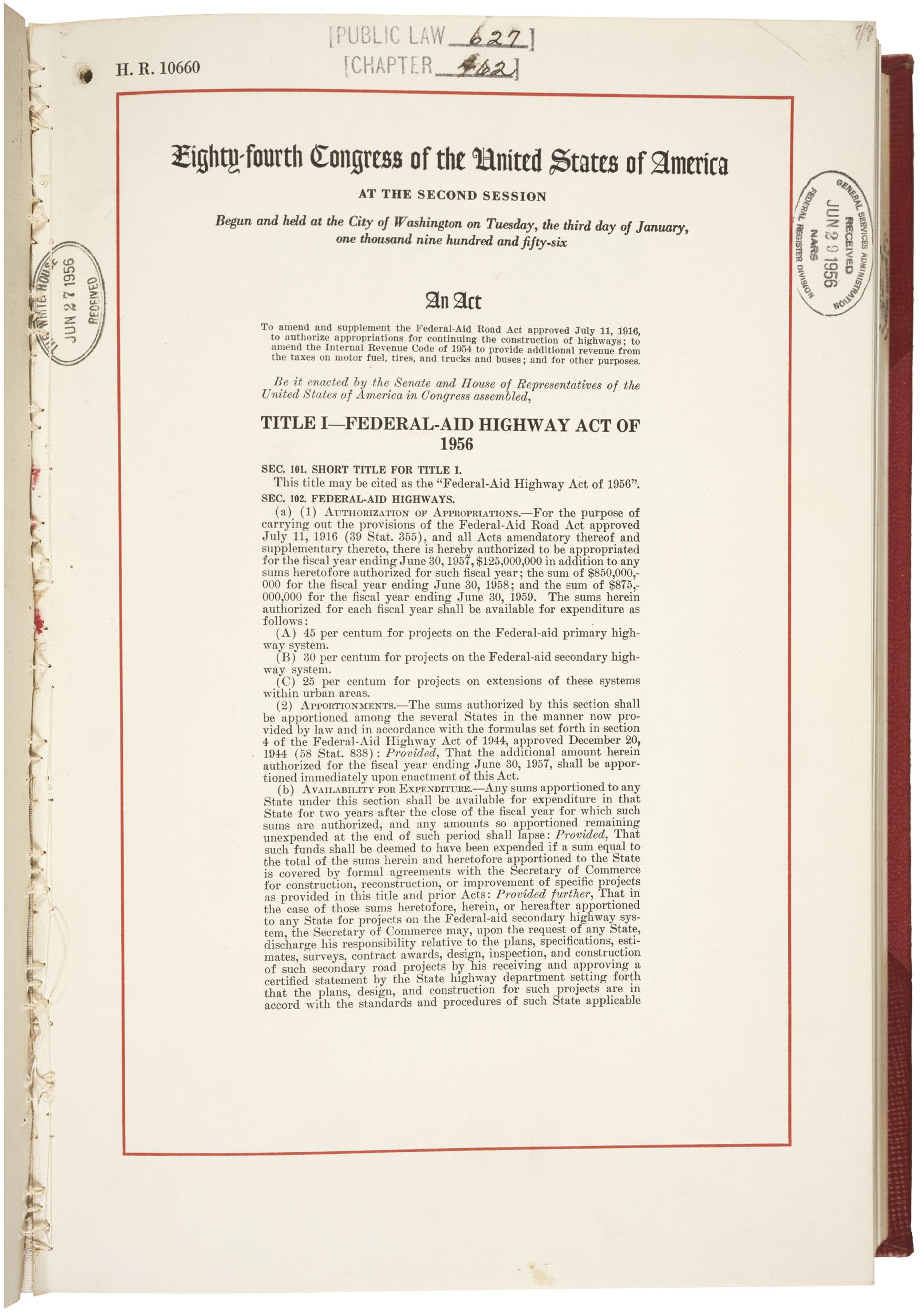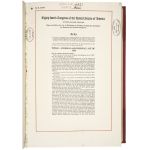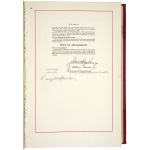National Interstate and Defense Highways Act
6/29/1956
Add to Favorites:
Add all page(s) of this document to activity:

Add only page 1 to activity:
Add only page 2 to activity:
Add only page 3 to activity:
Popularly known as the National Interstate and Defense Highways Act of 1956, the Federal-Aid Highway Act of 1956 authorized the building of highways throughout the nation and established an interstate highway system in the United States.
The movement behind the construction of a transcontinental superhighway started in the 1930s when President Franklin D. Roosevelt expressed interest in the construction of a network of toll superhighways that would provide more jobs for people in need of work during the Great Depression. The resulting legislation was the Federal-Aid Highway Act of 1938, which directed the chief of the Bureau of Public Roads (BPR) to study the feasibility of a six-route toll network.
With America on the verge of joining World War II in Europe, the time for a massive highway program had not arrived. At the end of the war, however, the Federal-Aid Highway Act of 1944 funded highway improvements and established major new ground by authorizing and designating, in Section 7, the construction of 40,000 miles of a "National System of Interstate Highways."
When President Dwight D. Eisenhower took office in January 1953, the states had only completed 6,500 miles of the system improvements. Eisenhower had first realized the value of good highways in 1919, when he participated in the U.S. Army's first transcontinental motor convoy from Washington, DC, to San Francisco. During World War II, Eisenhower saw the German advantage that resulted from their autobahn highway network, and he also noted the enhanced mobility of the Allies, on those same highways, when they fought their way into Germany. These experiences significantly shaped Eisenhower's views on highways and their role in national defense. During his State of the Union Address on January 7, 1954, Eisenhower made it clear that he was ready to turn his attention to the nation's highway problems. He considered it important to "protect the vital interest of every citizen in a safe and adequate highway system."
Between 1954 and 1956, there were several failed attempts to pass a national highway bill through Congress. The main controversy over the highway construction was the apportionment of the funding between the federal government and the states. Undaunted, the President renewed his call for a "modern, interstate highway system” in his 1956 State of the Union Address.
Within a few months, after considerable debate and amendment in Congress, the Federal-Aid Highway Act of 1956 emerged from the House-Senate conference committee. In the act, the interstate system was expanded to 41,000 miles. To construct the network, $25 billion was authorized for fiscal years 1957 through 1969. Eisenhower signed the bill into law on June 29th.
Because of the 1956 law, and the subsequent Highway Act of 1958, the pattern of community development in America was fundamentally altered and was henceforth based on the automobile. In urban areas, massive superhighways cut through neighborhoods and destroyed housing, much of it in poorer sections of the city. Elsewhere, the new superhighways followed established railroad routes and so bypassed many small towns and rural merchants. While the construction and routing of the national transportation network evolved in response to community and environmental concerns, the increased mobility Americans enjoyed as a result of the interstate highway system spurred substantial growth in interstate commerce and suburbanization over the next decades.
The movement behind the construction of a transcontinental superhighway started in the 1930s when President Franklin D. Roosevelt expressed interest in the construction of a network of toll superhighways that would provide more jobs for people in need of work during the Great Depression. The resulting legislation was the Federal-Aid Highway Act of 1938, which directed the chief of the Bureau of Public Roads (BPR) to study the feasibility of a six-route toll network.
With America on the verge of joining World War II in Europe, the time for a massive highway program had not arrived. At the end of the war, however, the Federal-Aid Highway Act of 1944 funded highway improvements and established major new ground by authorizing and designating, in Section 7, the construction of 40,000 miles of a "National System of Interstate Highways."
When President Dwight D. Eisenhower took office in January 1953, the states had only completed 6,500 miles of the system improvements. Eisenhower had first realized the value of good highways in 1919, when he participated in the U.S. Army's first transcontinental motor convoy from Washington, DC, to San Francisco. During World War II, Eisenhower saw the German advantage that resulted from their autobahn highway network, and he also noted the enhanced mobility of the Allies, on those same highways, when they fought their way into Germany. These experiences significantly shaped Eisenhower's views on highways and their role in national defense. During his State of the Union Address on January 7, 1954, Eisenhower made it clear that he was ready to turn his attention to the nation's highway problems. He considered it important to "protect the vital interest of every citizen in a safe and adequate highway system."
Between 1954 and 1956, there were several failed attempts to pass a national highway bill through Congress. The main controversy over the highway construction was the apportionment of the funding between the federal government and the states. Undaunted, the President renewed his call for a "modern, interstate highway system” in his 1956 State of the Union Address.
Within a few months, after considerable debate and amendment in Congress, the Federal-Aid Highway Act of 1956 emerged from the House-Senate conference committee. In the act, the interstate system was expanded to 41,000 miles. To construct the network, $25 billion was authorized for fiscal years 1957 through 1969. Eisenhower signed the bill into law on June 29th.
Because of the 1956 law, and the subsequent Highway Act of 1958, the pattern of community development in America was fundamentally altered and was henceforth based on the automobile. In urban areas, massive superhighways cut through neighborhoods and destroyed housing, much of it in poorer sections of the city. Elsewhere, the new superhighways followed established railroad routes and so bypassed many small towns and rural merchants. While the construction and routing of the national transportation network evolved in response to community and environmental concerns, the increased mobility Americans enjoyed as a result of the interstate highway system spurred substantial growth in interstate commerce and suburbanization over the next decades.
Transcript
AN ACTTo amend and supplement the Federal-Aid Road Act approved July 11, 1916, to authorize appropriations for continuing the construction of highways; to amend the Internal Revenue Code of 1954 to provide additional revenue from the taxes on motor fuel, tires, and trucks and buses; and for other purposes.
Be it enacted by the Senate and House of Representatives of the United States of America in Congress assembled,
TITLE I—FEDERAL-AID HIGHWAY ACT OF 1956
SEC. 101. SHORT TITLE FOR TITLE I.
This title may be cited as the "Federal-Aid Highway Act of 1956".
SEC. 102. FEDERAL-AID HIGHWAYS.
(a) (1) AUTHORIZATION OF APPROPRIATIONS.—For the purpose of carrying out the provisions of the Federal-Aid Road Act approved July 11, 1916 (39 Stat. 355), and all Acts amendatory thereof and supplementary thereto, there is hereby authorized to be appropriated for the fiscal year ending June 30, 1957, $125,000,000 in addition to any sums heretofore authorized for such fiscal year; the sum of $850,000,000 for the fiscal year ending June 30, 1958; and the sum of $875,000,000 for the fiscal year ending June 30, 1959. The sums herein authorized for each fiscal year shall be available for expenditure as follows:
(A) 45 per centum for projects on the Federal-aid primary highway system.
(B) 30 per centum for projects on the Federal-aid secondary highway system.
(C) 25 per centum for projects on extensions of these systems within urban areas.
(2) APPORTIONMENTS.—The sums authorized by this section shall be apportioned among the several States in the manner now provided by law and in accordance with the formulas set forth in section 4 of the Federal-Aid Highway Act of 1944; approved December 20, 1944 (58 Stat. 838) : Provided, That the additional amount herein authorized for the fiscal year ending June 30, 1957, shall be apportioned immediately upon enactment of this Act.
(b) AVAILABILITY FOR EXPENDITURE.—Any sums apportioned to any State under this section shall be available for expenditure in that State for two years after the close of the fiscal year for which such sums are authorized, and any amounts so apportioned remaining unexpended at the end of such period shall lapse: Provided, That such funds shall be deemed to have been expended if a sum equal to the total of the sums herein and heretofore apportioned to the State is covered by formal agreements with the Secretary of Commerce for construction, reconstruction, or improvement of specific projects as provided in this title and prior Acts: Provided further, That in the case of those sums heretofore, herein, or hereafter apportioned to any State for projects on the Federal-aid secondary highway system, the Secretary of Commerce may, upon the request of any State, discharge his responsibility relative to the plans, specifications, estimates, surveys, contract awards, design, inspection, and construction of such secondary road projects by his receiving and approving a certified statement by the State highway department setting forth that the plans, design, and construction for such projects are in accord with the standards and procedures of such State applicable
[pages omitted]
property (real or personal, and including office equipment and records) used or held in connection with such functions, duties, and authority.
(d) EFFECTUATION OF TRANSFER. The Secretary of the Interior and the Secretary of Commerce shall take such steps as may be necessary or appropriate to effect the transfer from the Department of the Interior to the Department of Commerce of the functions, duties, and authority, and the funds and property, as herin provided for.
(e) DISTRIBUTION OF FUNCTIONS. The Secertary of Commerce shall have power, by order or regulations, to distribute the functions, duties, and authority hereby transferred, and appropriations pertaining thereto, as he may deem proper to accomplish the economical and effective organization and administration thereof.
SEC. 108. NATIONAL SYSTEM OF INTERSTATE AND DEFENSE HIGHWAYS.
(a) INTERSTATE SYSTEM. It is hereby declared to be essential to the national interest to provide for the early completion of the "National System of Interstate Highways", as authorized and designated in accordance with section 7 of the Federal-Aid Highway Act of 1944 (58 Stat. 838). It is the intent of the Congress that the Interstate System be completed as nearly as practicable over a thirteen-year period and that the entire System in all the States be brought to simultaneous completion. Because of its primary importance to the national defense, the name of such system is hereby changed to the "National System of Interstate and Defense Highways". Such National System of Interstate and Defense Highways is hereinafter in this Act referred to as the "Interstate System".
(b) AUTHORIZATION OF APPROPRIATIONS. For the purpose of expediting the construction, reconstruction, or improvement, inclusive of necessary bridges and tunnels, of the interstate System, including extensions thereof through urban areas, designated in accordance with the provisions of section 7 of the Federal-Aid Highway Act of 1944 (58 Stat. 838), there is hereby authorized to be appropriated the additional sum of $1,000,000,000 for, the fiscal year ending June 30, 1957 , which sum shall be in addition to the authorization heretofore made for that year, the additional sum of $1,700,000,000 for the fiscal year ending June 30, 1958, the additional sum of $2,000,000,000 for the fiscal year ending June 30, 1959, the additional sum of $2,200,000,000 for the fiscal year ending June 30, 1960, the additional sum of $2,200,000,000 for the fiscal year ending June 30, 1961, the additional sum of $2,200,000,000 for the fiscal year ending June 30, 1962, the additional sum of $2,200,000,000 for the fiscal year ending June 30, 1963, the additional sum of $2,200,000,000 for the fiscal year ending June 30, 1964, the additional sum of $2,200,000,000 for the fiscal year ending June 30, 1965, the additional sum of $2,200,000,000 for the fiscal year ending June 30, 1966, the additional sum of $2,200,000,000 for the fiscal year ending June 30, 1967, the additional sum of $1,500,000,000 for the fiscal year ending June 30, 1968, and the additional sum of $1,025,000,000 for the fiscal year ending .June 30, 1969.
(c) APPORTIONMENTS FOR 1956, 1958, AND 1959. The additional sums herein authorized for the fiscal years ending June 30, 1957, June 30, 1958, and June 30, 1959, shalle be apportioned among the several States in the following manner: one-half in the ration which the population of each State bears to the total population of all the States, as shown by the latest available Federal census: Provided, That no State shall receive less than three-fourths of 1 per centum of the money so apportioned; and one-half in the manner now provided by law for the apportionment of funds for the Federal-aid primary system. The additional sum herein authorized for the fiscal year ending June 30, 1957,
[pages omitted]
carrying out the study and investigation required by this section. Each such report shall be printed as a House document of the session of the Congress to which the report is made.
(e) FUNDS FOR STUDY AND INVESTIGATION. There are hereby authorized to be appropriated out of the Highway Trust Fund such sums as may be necessary to enable the Secretary of Commerce to carry out the provisions of this section.
SEC. 211. EFFECTIVE DATE OF TITLE
This title shall take effect on the date of its enactment, except the amendments made by sections 202, 203, 204, and 205 shall take effect on July 1, 1956.
TITLE III - SPEARABILITY
SEC. 301. SEPARABILITY
If any section, subsection, or other provision of this Act or the application thereof to any person or circumstance is held invalid, the remainder of thei Act and application of such section, subsection, or other provision to other persons or circumstances shall not be affected thereby.
[endorsements]
This primary source comes from the General Records of the United States Government.
National Archives Identifier: 5730930
Full Citation: An Act of June 29, 1956, Public Law 84-627, 70 STAT 374, to Amend and Supplement the Federal-Aid Road Act Approved July 11, 1916, to Authorize Appropriations for Continuing the Construction of Highway; 6/29/1956; Enrolled Acts and Resolutions of Congress, 1789 - 2011; General Records of the United States Government, Record Group 11; National Archives Building, Washington, DC. [Online Version, https://www.docsteach.org/documents/document/national-interstate-defense-highways-act, April 26, 2024]Rights: Public Domain, Free of Known Copyright Restrictions. Learn more on our privacy and legal page.






